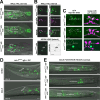This is a preprint.
A neurotransmitter atlas of C. elegans males and hermaphrodites
- PMID: 38895397
- PMCID: PMC11185579
- DOI: 10.1101/2023.12.24.573258
A neurotransmitter atlas of C. elegans males and hermaphrodites
Update in
-
A neurotransmitter atlas of C. elegans males and hermaphrodites.Elife. 2024 Oct 18;13:RP95402. doi: 10.7554/eLife.95402. Elife. 2024. PMID: 39422452 Free PMC article.
Abstract
Mapping neurotransmitter identities to neurons is key to understanding information flow in a nervous system. It also provides valuable entry points for studying the development and plasticity of neuronal identity features. In the C. elegans nervous system, neurotransmitter identities have been largely assigned by expression pattern analysis of neurotransmitter pathway genes that encode neurotransmitter biosynthetic enzymes or transporters. However, many of these assignments have relied on multicopy reporter transgenes that may lack relevant cis-regulatory information and therefore may not provide an accurate picture of neurotransmitter usage. We analyzed the expression patterns of 16 CRISPR/Cas9-engineered knock-in reporter strains for all main types of neurotransmitters in C. elegans (glutamate, acetylcholine, GABA, serotonin, dopamine, tyramine, and octopamine) in both the hermaphrodite and the male. Our analysis reveals novel sites of expression of these neurotransmitter systems within both neurons and glia, as well as non-neural cells. The resulting expression atlas defines neurons that may be exclusively neuropeptidergic, substantially expands the repertoire of neurons capable of co-transmitting multiple neurotransmitters, and identifies novel neurons that uptake monoaminergic neurotransmitters. Furthermore, we also observed unusual co-expression patterns of monoaminergic synthesis pathway genes, suggesting the existence of novel monoaminergic transmitters. Our analysis results in what constitutes the most extensive whole-animal-wide map of neurotransmitter usage to date, paving the way for a better understanding of neuronal communication and neuronal identity specification in C. elegans.
Conflict of interest statement
CONFLICT OF INTEREST The authors declare no conflicts of interest.
Figures














References
-
- Alfonso A., Grundahl K., McManus J. R., Asbury J. M. and Rand J. B., 1994. Alternative splicing leads to two cholinergic proteins in Caenorhabditis elegans. J Mol Biol 241: 627–630. - PubMed
-
- Alkema M. J., Hunter-Ensor M., Ringstad N. and Horvitz H. R., 2005. Tyramine Functions independently of octopamine in the Caenorhabditis elegans nervous system. Neuron 46: 247–260. - PubMed
Publication types
Grants and funding
LinkOut - more resources
Full Text Sources
